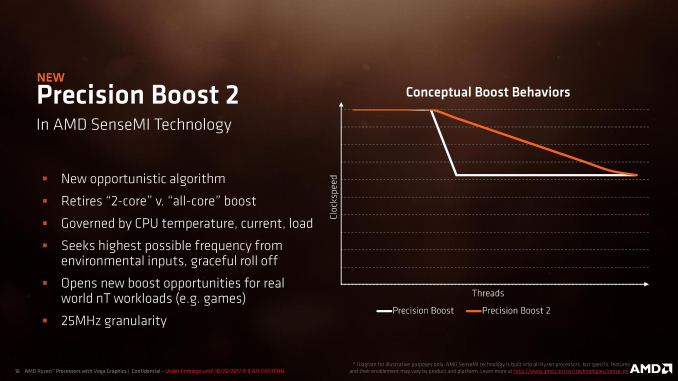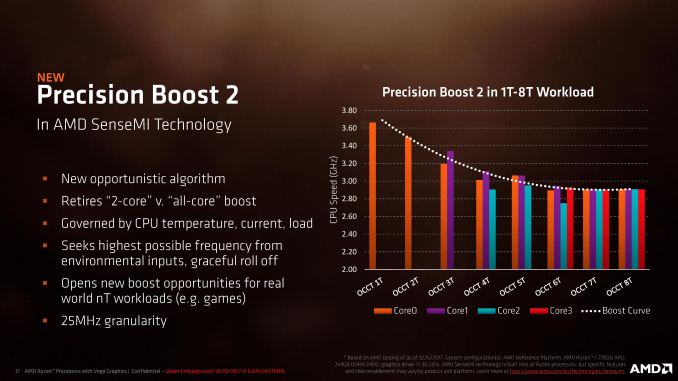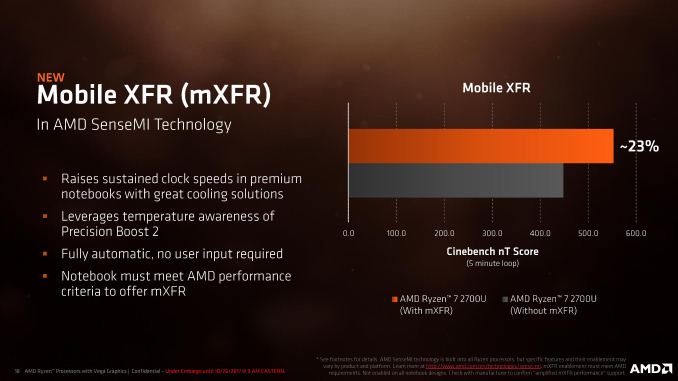Ryzen Mobile is Launched: AMD APUs for Laptops, with Vega and Updated Zen
by Ian Cutress on October 26, 2017 9:00 AM ESTSense Me Ryzen: Better Boost
When AMD launched the desktop Zen processors, it also branded a series of five technologies under the ‘SenseMI’ name. We covered these in detail in our Ryzen 7 review, but in short, it covers the following:
- Pure Power: Sensors to optimize power consumption
- Precision Boost: Determines how Turbo is applied
- Extreme Frequency Range: Going above maximum turbo when possible
- Neural Net Prediction: Using Neural Nets for prefetching data
- Smart Prefetch: Algorithms that work to enhance prefetch
With Ryzen Mobile, the features relating to frequency get an updated model, while Pure Power gets a bigger boost. We’ll cover the power changes on the next page, but it is worth talking about how AMD has improved Precision Boost and brought XFR to laptops.
Precision Boost 2
Most CPU turbo algorithms work by sensing how many cores and threads are under load, determining if the CPU has enough power headroom, and applying a voltage. This is why in the past both of the major x86 CPU manufacturers will quote a ‘per-core turbo frequency’ to show what the frequency should be when different numbers of cores are loaded and all else is fine (there is temperature/power headroom).
For Ryzen Mobile, AMD is pivoting to a new turbo model. When the system is in the P0 (top) turbo state, the system will use a new opportunistic turbo algorithm that rather than being based on the cores under load, is governed by CPU temperatures, currents, and how much load is being applied. The algorithm takes into account all the environmental inputs, such as skin temperature sensors and battery life, and will provide the best turbo frequency it can, regardless of if one thread is being used or all threads are being used.
It will be able to provide boost amounts at the 25 MHz granularity level, similar to how the desktop processors work, with the idea being that in most cases, if the system has a lot of cores available and a background process performs some very light work (such as checking for updates), rather than dropping 500-800 MHz because more cores are loaded, the system will keep at the high frequency.
AMD is stating that this has a big effect on real-world workloads, typically those that have variable thread workloads such as gaming.
When asked if Precision Boost 2 would be coming to the next generation of AMD’s Desktop Ryzen processors, I was told that ‘it could be inferred / it’s a safe bet’.
Mobile Extended Frequency Range (mXFR)
Because mobile systems are thermally limited, battery limited, power limited, and battery limited, offering ‘extra’ turbo headroom is not really something that processor manufacturers like to do. As a result, most of the Ryzen Mobile-powered notebooks will not have any form of XFR – AMD will be allowing it on a case-by-case basis for vendors that overengineer their chassis to be capable of supporting a higher power profile.
This feature essentially extends the average level at which Precision Boost 2 will operate, and also marks what could be considered a higher configurable TDP. One of the systems being launched with Ryzen Mobile this side of Christmas will be mXFR enabled, because the chassis is designed for 25W rather than 15W. It is worth noting that AMD states the configurable TDP of the Ryzen Mobile chips goes up to 25W, so this is likely the case what is happening.
Encode and Decode
AMD is fully using Vega’s encode and decode capabilities with Ryzen Mobile. The big inclusion for AMD’s mobile devices is the ability to decode VP9, the codec prefered in particular by YouTube.
| AMD Ryzen Mobile Encode/Decode Capabilities | |||||
| Decode 1080p @ 4:2:0 |
Decode 2160p @ 4:2:0 |
Encode 1080p |
Encode 1440p |
Encode 2160p |
|
| MPEG2 | 60 FPS | - | |||
| VC1 | 60 FPS | - | |||
| VP9 8/10 bpc | 240 FPS | 60 FPS | |||
| H.264 8 bpc | 240 FPS | 60 FPS | 120 FPS | 60 FPS | 30 FPS |
| H.264 10 bpc | 240 FPS | 60 FPS | |||
| HEVC 8bpc | 240 FPS | 60 FPS | 120 FPS | 60 FPS | 30 FPS |
| HEVC 10 bpc | 240 FPS | 60 FPS | |||
| JPEC 8bpc | 240 FPS | 60 FPS | |||













140 Comments
View All Comments
neblogai - Friday, October 27, 2017 - link
Still, it is HP that is the worst here. Lenovo is light ultra portable, small dimentions at 15W- not meant/able to do gaming anyway. Ram is soldered same like on it's Intels 'APUs'. Acer Swift- configured with 25W cooling(so should get mXFR certification) and dual channel, IPS, SSD- and not heavy. Good specs and can do gaming. But HP- the heaviest, and not sure what cooling- could very well be 15W, where iGPU simply will not have enough power to provide good results. By the way- game results on AMD's slide come from this HP x360.Alexvrb - Saturday, October 28, 2017 - link
Even at 15W I'd take the HP over the Lenovo just for that single channel cluster. The Acer does look really interesting, but you'd definitely be buying it for performance first and battery life second.The bottom line is there's a tradeoff for all the above models, though the Acer looks most appealing to me on paper.
neblogai - Sunday, October 29, 2017 - link
I'd definitely pick the Lenovo, as laptop is only of value to me if it is extremely portable. Was even measuring it as an upgrade to my Surface Pro2- and 13.3" Lenovo is about the same weight, and only 3cm wider, 4 cm longer. R5 2500U is much faster than i5-4300U, comes with 8 GB vs 4GB RAM, and would perform better in old games as well.aebiv - Thursday, October 26, 2017 - link
I'm looking forward to Compulab updating their older AMD APU powered bricks to these chips.I just wish Thunderbolt 3 wasn't tied to Intel.
Computer Bottleneck - Thursday, October 26, 2017 - link
Thunderbolt 3 will be royalty free next year.Rene23 - Thursday, October 26, 2017 - link
A pity has a Ideapad 720S in the pipeline instead of a ThinkPad. Given that they just came out with the AMD based A275 und A475 it probably takes some time until we see a Ryzen Thinkpad - if ever.One could get the impression that some companies intentionally cripple the AMD options. E.g. old, underperforming silicon ThinkPad and crippled low cost mode with the Ryzen (Ideapad); and the often seen single memory channel.
Maybe Intel even pays them to intentionally outperform the AMD flavors, ... :-/
Valantar - Thursday, October 26, 2017 - link
I think the situation might be the complete opposite - after all, these chips use the exact same socket/BGA array as Bristol Ridge, meaning that all Lenovo needs to do is update their BIOSes and change the CPUs, and they'd be off to the races. I (and a few others with me at the time) assumed that those laptops were launched specifically for this purpose - to have a ready-made, already-tested ThinkPad platform into which to slot Raven Ridge. After all, pro-level QC takes time, and it'd be easier to just test the CPU on a known platform rather than start from scratch.Still, I want a ThinkPad Yoga with a Ryzen 7 2700U. ThinkPad keyboard, this APU, good battery life and pen input? YES. Preferably with the 25W option, although if Intel parallelism is anything to go by, that would have to be a ThinkPad X1 Yoga (the 370 runs at 15W, the X1 at 25). Oh, and a 3:2 display. Are you listening, Lenovo?
Samus - Thursday, October 26, 2017 - link
I think ThinkPad (and HP Elitebooks) will be reserved for Intel at least through next year. HP does has an Elite-platform for AMD in the 7xx series (6xx, 8xx, 10xx are Intel only, and technically 6xx and Pro-platform) so it's possible we will see an Elitebook 745/755 that are Ryzen mobile...or they could introduced a whole new category like Elitebook 940/950 as a premium platform option sitting between their entry Elitebook 800's and Elitebook 1000's.mdriftmeyer - Friday, October 27, 2017 - link
These aren't the flag ship mobile APUs from AMD. Those arrive in Feb '18 and demonstrated at CES.Zizy - Thursday, October 26, 2017 - link
On page 2 AMD is claiming score of 707 in cinebench nT. On page 3, discussing mXFR, those graphs show 450 without and 550 with boost after 5 minutes of the test.A lot of throttling here.
(For reference, 65W 1500X gets about 800 points, so it isn't totally unexpected to be seeing just 450 points for sustained 15W)